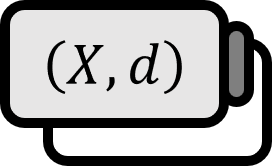Continuous and Uniformly Continuous in Metric Spaces
Definitions
Let’s define a function $f : E \to Y$ for two metric spaces $\left( X , d_{X} \right)$, $\left( Y , d_{Y} \right)$ and a subset $E\subset X$.
Let’s say $p \in E$. For any $\varepsilon > 0$, if there exists $\delta>0$ such that
$$ x \in E \quad \text{and} \quad d_{X}(p, x ) < \delta \implies d_{Y}(f(p) , f(x) ) < \varepsilon $$
is satisfied, then $f$ is said to be continuous at $p \in E$. If $f$ is continuous at every point of $E$, $f$ is called a continuous function on $E$.
For any $ \varepsilon > 0$, if there exists $\delta>0$ such that
$$ d_{X}(x_{1}, x_{2} ) < \delta \land x_{1}, x_{2} \in E \implies d_{Y}(f(x_{1}) , f(x_{2}) ) < \varepsilon $$
is satisfied, then $f$ is said to be uniformly continuous on $E$.
- $\land$ is a logical ‘and’ represented by the logical conjunction symbol.
Explanation
Continuity and uniform continuity can be defined beyond $\mathbb{R}$ for metric spaces. What’s different from continuity in $\mathbb{R}$ is that it is possible to generalize by changing $d_{1}$ and $d_{2}$.
On the other hand, a more sophisticated expression is used, such that for any $B_{d_{Y}} (f(p) , \varepsilon )$, if there exists $B_{d_{X}} (p , \delta)$ which satisfies $f(B_{d_{X}} (p , \delta)) \subset B_{d_{Y}} (f(p) , \varepsilon )$, then $f$ is said to be continuous at $p \in X$. Although it might seem too abstract and intimidating at first, you might find this expression becomes more comfortable as you keep observing it. Considering the generalization to topological spaces, it might be better to become accustomed sooner rather than later.
Theorem: Equivalent Conditions of a Continuous Function
For a function $f:X \to Y$, the following conditions are equivalent.
$f : X \to Y$ is continuous.
$\forall x \in X,\ \displaystyle \lim_{n \to \infty} p_{n} = p \implies \lim_{n \to \infty} f(p_{n}) = f(p)$
For all open sets $O$ in $Y$, $f^{-1} ( O )$ is an open set in $X$.
For all closed sets $C$ in $Y$, $f^{-1} ( C )$ is a closed set in $X$.
These characteristics can be useful in proving that a given function is continuous.

At first glance, the image above seems like a counterexample to the fourth condition. For the closed interval $[c,d]$, its preimage $f^{-1} [c,d]$ is $(a,b)$, and as we know, $(a,b)$ is an open interval. However, since $f : (a,b) \to \mathbb{R}$, $(a,b)$ becomes the entire space, and the entire space is a closed set, so it does not contradict the proposition.
